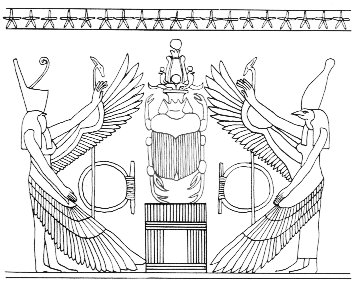|
TRANSLATIONS
The sun is often seen as a dung beetle (scarab) in the pictures from Egypt:
I guess that is why OgotemmÍli explained that the sun was feeding on the 'excrement' of the Nummo: '... When the sky is overcast, the sun's rays may be seen materializing on the misty horizon. These rays, excreted by the spirits, are of copper and are light. They are water too, because they uphold the earth's moisture as it rises. The Pair excrete light, because they are also light ...
... 'The sun's rays,' he went on, 'are fire and the Nummo's excrement. It is the rays which give the sun its strength. It is the Nummo who gives life to this star ...' The 4 sides of the square earth is depicted - I believe - by 4 feathery arms. Feathers mean fire, and fire is what sun needs. But if the sun is a dung beetle, the feathers (fire) must be excrement. Back to Tahua. With 4 viri I feel it necessary to investigate how far away from each other they are located (counted in number of glyphs):
The distance from b1-1 to b7-25 is 520 glyphs and the distance from a8-26 to b1-1 is 60 glyphs, both these numbers indicate intention:
But Aa5-7, the 4th member of the group (3 + 1 again) does not follow the pattern. I suggest that we measure the distance from Ab7-25 to Aa8-26 and jump over Aa5-7:
This of course means that we should understand the total number of glyphs on Tahua, 1334, as 46 * 29. Or rather as (20 + 26) * 29. It also means that we must read both sides together, because otherwise the number of glyphs on side a, 670, and the number of glyphs on side b, 664, would be possible to divide by 29. |
||||||||||||||||||||||||||||||||||||||||||||||||||||||||||||||||||||||||||||||||||||||||

